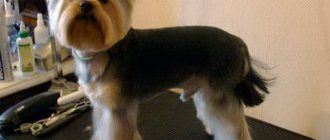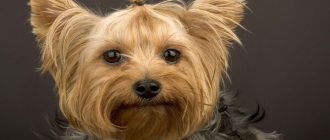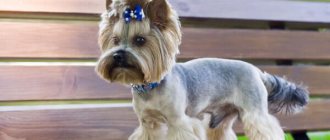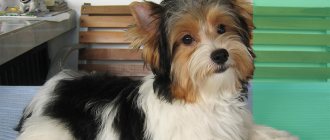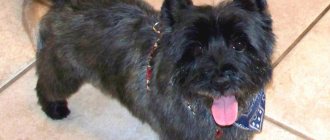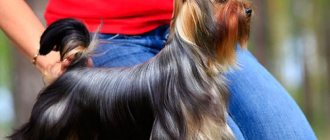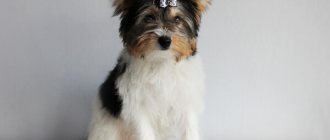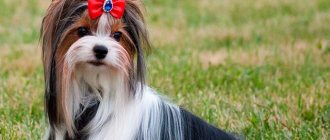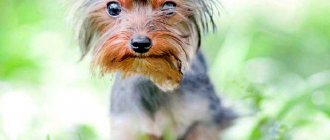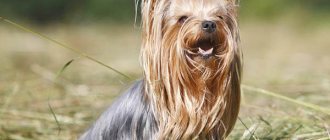The Yorkshire Terrier is one of the smallest decorative dogs. Its homeland is considered to be the county of Yorkshire, located in the northern part of England. Now this is the most popular breed among lap dogs. The size of the Yorkshire Terrier is so small that there are no limiting criteria for its minimum height and weight. The main condition of the Fédération Cynologique Internationale (FCI) standard is that the dog should not weigh more than 3.2 kilograms.
Cutie Yorkie
Yorkshire Terrier breed standard
The canonical types of Yorkshire terriers were established back in 1898, then supplemented in 2009:
- A long-haired dog, without down, so the hair falls evenly.
- The posture is compact and graceful, the body is strong.
- The head is small, without a prominent nose.
- Scissor bite.
- The ears are erect and covered with fur.
- The paws are straight, both the front and rear legs are straight, the shoulders are regular and symmetrical.
- The tail is docked or undocked. The latter is as straight as possible and complements the line of the back. And the docked one is worn a little higher. Both options are considered acceptable.
Varieties of Yorkshire terriers exist only among breeders experimenting with the size of their pets. The standard adopted in the CIS countries in 1988 does not define a minimum weight limit, setting only a maximum of 3.1 kg.
Rock defects
Yorkies with:
- semi-erect ears;
- underbite or underbite;
- non-standard color;
- cryptorchidism.
Defects also include too bulging or incorrectly set eyes, defects in the structure of the paws, lack or modification of teeth, a short or long massive neck, and a low-slung croup. It is noteworthy that animals that are not gaining weight are traditionally not welcomed.
Standard sizes
The official breed standard adopted by the ICF and RKF provides a list of basic criteria that the Yorkshire Terrier must meet. In it, in addition to the general appearance of the dog, its temperament, coat structure, color and other things, the dimensions are also indicated.
The standard does not have regulations regarding the minimum height of a Yorkie, but the maximum allowable figure is established - the height of a standard Yorkshire terrier at the withers should not exceed 25 cm . Most often, males grow up to 23 cm at the withers, females - up to 20 cm.
The height of the dog at the withers should coincide with the height at the croup.
Body length is also important for Yorkies, which must be measured from the withers to the base of the tail. According to the standard, the body of a Yorkshire Terrier should be square, which means that the length and height of the dog should be approximately the same.
The length of the body should not exceed the height of the front legs (an excess of even 2 cm is noticeable and unacceptable), ideally it should be 1-1.5 cm less, then the dog’s figure is considered well balanced.
It should be taken into account that only exhibition representatives of the breed are evaluated according to these parameters.
Expert opinion
Kozhevin Semyon Kirillovich
Expert dog handler.
Even before purchasing a puppy, you need to decide for what purpose it is being purchased - to participate in exhibitions or simply as a pet. If a show career is planned for your pet, then choosing a puppy must be approached with maximum responsibility, because... a pet-class puppy is unlikely to accurately meet all the criteria of the breed standard. However, it must be said that today the boundaries of the standard are quite blurred and a Yorkshire terrier with a weight and height much greater than the recommended one is not uncommon. All the indicators specified in the standard, by and large, only help judges at competitions decide which dog to give preference to.
Yorkshire Terrier breed large standard
These are the so-called big Yorkies. In fact, this is the optimal size for a small animal. A large Yorkshire Terrier weighs from 2 to 3.1 kg. He has a balance between size, classic appearance and health.
Dogs exceeding the 3.1 kg mark are outside the breed limits. This is not a problem if the “Yorkshire Terrier Maxi” is bought exclusively as a pet and will not participate in exhibitions. But he is not suitable for breeding, since he does not have the canonical weight.
The Great Yorkshire Terrier may appear due to the mating of a large male and female, or due to the mixing of species with another, larger one.
Pros and cons of a dog
Characteristics of advantages:
- Yorkies are loyal and make excellent family pets.
- They hardly need any exercise.
- Yorkshire Terriers are adaptable and can live in an apartment or house.
- They are usually long-lived individuals.
- Yorkies are smart dogs that learn new tricks quickly.
- The pet does not smell or stink.
Characteristics of minuses:
- The disadvantage is that some individuals may bark constantly.
- Dogs are not suitable for families with small children.
- Their coat requires special care and needs daily brushing.
- Yorkshire Terriers are predisposed to some serious health problems.
- Pets shed.
- This is an allergenic breed.
Yorkshire Terrier mini
Stand out as amateurs. People unfamiliar with the official standards should study all the information about these conventional varieties before purchasing a puppy. Artificially reduced dogs often have genetic abnormalities and diseases from birth that significantly shorten their lifespan.
Mini Yorkie: standard
The main indicator is weight from 1.5 to 2 kg. Such puppies are obtained when a standard female and a small male are brought together. When buying puppies, it is important to pay attention to their condition: unscrupulous breeders underfeed them, achieving miniature size. This affects:
- the already fragile health of Yorkies;
- psychological state of the pet;
- his training abilities.
If standards quite successfully assimilate commands, have a calm and balanced character, then reduced representatives experience difficulties in learning and are aggressive towards others. When getting a dwarf Yorkshire terrier, you should remember that the smaller the dog, the more difficult it is to care for and train it.
Difficulties in caring for a micro Yorkshire terrier
Completely dwarf Yorkies or super minis weigh up to 1.5 kg. These pets are different:
- poor health, problems with the skeleton, internal organs;
- low intelligence;
- short life.
Sure, they look cute, but keeping a Micro Yorkie is very difficult. He must be protected from falls even from a small height; when running, they often break limbs. In addition, due to its low intelligence, the mini Yorkshire Terrier is difficult to train.
Mini and super mini bitches are not suitable for breeding. They are unable to bear and give birth to puppies normally. The temptation to get a dog smaller than a cat is quite strong, but you need to be prepared for serious difficulties.
Puppies
Newborn pets weigh about 0.7 kilograms. A puppy's appearance is slightly different from an older, mature dog. It has short, soft fur, black and brown in color. The dog's eyes will remain closed for up to 2-3 weeks. Month-old babies still have poor vision.
The appearance of a puppy in your home should occur no earlier than when it reaches 2 months of age.
How to care for a puppy?
Taking care of a two-month-old Yorkie is not that difficult. Love and attention are the basic needs of your new friend from birth.
- Puppies need a balanced, nutritious diet, which can only be provided by quality food.
- Provide your Yorkie with a diet that is tailored to their height and weight. They need to eat at least three times a day. Until the puppy reaches three months of age, there should be food in the bowl constantly. Water should also always be available.
- Your pet should chew the treats you offer with ease. Treats that are too hard can cause blockage in the trachea or other airways.
- Caring for your Yorkie includes taking care of teething. Buy a few special toys so your pet can chew on them.
- Puppies sleep a lot. A normal puppy sleeps on average 13 hours a day. Even if he sleeps 18 hours a day, this is also normal. Set up a corner for relaxation.
- You should incorporate time to care for your puppy into your daily routine. Grooming should include bathing, brushing, trimming nails, cleaning ears, and so on.
- Proper exercise on a daily basis is extremely important for your Yorkie's health. Running around the house won't be enough. Set a specific time each day when you take your puppy outside for fresh air. Give him some exercise there.
- Puppy proofing your home is very important. They are curious explorers! Make sure that there are no electrical wires or other dangerous objects within their reach.
Which Yorkie is better: standard or mini?
Due to the great demand for dwarf breeds, their price is rapidly increasing. However, professional breeders recommend choosing a pet from 2 to 3 kg, i.e. large standard. It has significant advantages:
- health and normal immunity;
- possibility of breeding;
- learning ability;
- he is recognized at shows in the classics of the breed.
He gets along well with children and other dogs. Miniature puppies also appear in standard-sized Yorkies. But breeding them on purpose is a risky and unjustified activity.
Breeds are already degenerating due to selection: modern terriers are much sicker than they were 100 years ago. Therefore, when choosing a pet, it is advised to choose recognized standards so as not to be disappointed by the short life of the dog.
What is the difference between a mini Yorkie and a standard Yorkie - similarities and differences
The main characteristic by which a Mini Yorkie can be distinguished from a standard one is the weight of the dog. We already said above that dogs weigh 1.6-2.2 kg. are considered “mini”, and “standards” start from 2.5 to 3.2 kg. But this is not the only distinguishing feature.
These two breed varieties can also be easily recognized by the structure of the skull and the shape of the animal’s muzzle. In individuals classified as the “standard” type, the muzzle has a classic shape; it cannot be called either shortened or elongated. In “mini” dogs, the muzzle resembles a doll’s or child’s face; it is shortened with a perky upturned nose.
Important: the puppet structure of the skull is transmitted only through the male line from male dogs. It is important to take this into account when crossing.
Similarities between standard and mini Yorkies
If you do not take into account the difference in weight and size, as well as some differences in the shape of the skull and muzzle, then we can say that the Mini Yorkie is a smaller copy of the “standard”. They have similar exterior characteristics and the same character. These are friendly and sociable pets. In terms of health, small Yorkies also do not differ from standard dogs.
Important: Mini Yorkies are absolutely healthy dogs whose parents may have standard sizes.
What is the difference between a mini Yorkie and a standard Yorkie?
Differences between Mini York and Standard
A conversation about the differences between standard and mini-Yorks must begin with dimensions: weight, height, body length. But this is not the only distinctive characteristic by which one can accurately determine whether a dog belongs to a particular species.
York "mini" and "standard" - the difference
- Mini Yorkies are called "baby faces". These dogs have a short muzzle and a funny upturned nose. The skull is different from that of standard sized animals. Because of this structure of the skull and the exterior of the dog’s muzzle, they look very cute. Dogs with a “tail” and a bow tied on their heads are especially adorable.
- Due to the special structure of the muzzle (short size), the eyes of mini-dogs look bulging. This is dangerous for the health of pets. The eyes of such pets may be more likely to be injured. A narrowed tear duct is a common cause of chronic conjunctivitis.
- The expression in the eyes of miniature dogs can be empty or stupid. The eyes of large terriers look lively and more emotional.
- Smaller skulls in mini pets cause breathing problems. Dogs snore during sleep and often make grunting sounds during walks and during active games, like other dogs of brachycephalic breeds.
- Baby-faces have smaller teeth, while standard ones have larger teeth. Earlier change of teeth is another distinctive feature of miniature dogs. Baby dogs have their teeth brushed every day, and their diet must contain mineral supplements with a high calcium content.
- Only standard Yorkies are allowed for exhibitions; baby-face dogs are adopted only as family pets and companions.
- Miniature bitches cannot carry offspring well and give birth to puppies on their own; they require obstetric care (caesarean section).
- Baby-face dogs are more timid than their standard counterparts. They require competent early socialization.
- Mini pets are suitable for going out and can be taken with you in a handbag.
- Small dogs are more susceptible to injury; they should not be allowed to jump from elevated surfaces: sofas, chairs, stairs.
- “Standards” are better adapted for life in families with preschool children. Having miniature pets in such families inevitably exposes the health of the dogs to the risk of accidental injury while playing with small family members.
- Standard terriers have a stronger hunter instinct. They are more passionate and self-confident. Such pets boldly bark at larger dogs, without fear of possible consequences.
- The lifespan of small Yorkies is 9 years; standard dogs can live up to 14-20 years.
Important: mini pets are not suitable for breeding. Babyfaces are the offspring of standard-sized dogs. Therefore, they are less common and more expensive.
Standard York
How to identify a baby-face pet
If you want to adopt a charming pet, a baby-face puppy, you need to be able to identify this sign.
In order not to make a mistake and choose a mini-York, you need to:
- Measure the distance from the tip of the dog's nose to the base of its muzzle. This will be the first dimension;
- then measure the length from the occipital protuberance to the tip of the nose. This will be the second dimension;
- after that, divide the first dimension by the second.
If these calculations result in a ratio of one to three, then this puppy is considered a baby face puppy.
Description of the breed
Yorkshire Terriers are small decorative dogs suitable for the home with a long and smooth coat, unique grace and proud bearing.
Exterior of Yorkies in accordance with the breed standard:
- a compact, strong body of a square format with a straight back line, a muscular loin and a short croup with a slope to the base of the tail;
- the chest is oval, the withers are weakly expressed;
- limbs are straight, strong, with well-developed knee and hock joints;
- brushes rounded, claws black;
- the head is small, with a clearly defined transition from the forehead to the short muzzle;
- scissor bite;
- the nose is small, the nostrils are rounded, the lobes are black;
- eyes are small, round, dark;
- the ears are triangular, small, erect, set high;
- the tail is set high, densely covered with as dark hair as possible.
The tail can be natural length or docked.
More details can be found here.
The following are visual photos of girls and boys of this breed.
Diseases
With proper care and nutrition, your pet will rarely get sick. If your baby gets sick, it is better to contact a specialist.
Below are some Yorkshire Terrier diseases that you need to know about.
- Congenital portosystemic shunt. Portosystemic shunt is also known as liver bypass. This is a problem that Yorkies are genetically predisposed to. Congenital portosystemic shunts occur in slightly less than 0.2% of all purebred dogs. Defects in the development of veins cause abnormal blood flow. Some of the blood flows around the liver, not through it. Consequently, the liver cannot completely eliminate toxins. This results in stunted growth, seizures and behavioral problems. In some cases, the problem can be treated with diet and medication, while in others it requires surgery.
- Cushing's disease. Yorkshire Terriers have a high predisposition to Cushing's disease. It is caused by an overreactive adrenal gland that produces too many steroid hormones. Symptoms of Cushing's disease include excessive urination, increased appetite, decreased activity, thin skin, and hair loss. Treatment is carried out with medication, under the close supervision of a specialist.
- Heart problems. Heart failure is the leading cause of death in older Yorkshire terriers. Two conditions they are prone to are patent ductus arteriosus and mitral valve disease. Signs: the dog is breathing heavily, wheezing, choking, coughing, has shortness of breath, gets tired quickly. Dogs with these problems have a specific type of heart murmur. They can be eliminated with surgery.
- Hypoglycemia. All small dogs are prone to hypoglycemia. This condition can be fatal if not recognized and treated. To avoid a sharp drop in blood sugar levels, you need to feed small dogs more often than large breeds. This is especially true for the first few months of life. A dog with such an illness often shakes and trembles. Contact your veterinarian if you notice any of these signs in your pet.
- Legg-Calvé-Perthes disease. This is a hip problem that occurs in small breed dogs. The symptoms are caused by spontaneous degeneration of the femoral head. This is the long bone of the leg that is located in the femur area and allows for smooth rotation of their leg. The problem is treated surgically.
- Hemorrhagic gastroenteritis. This is an acute and serious illness that can lead to death. Symptoms include bloody diarrhea, vomiting, decreased appetite, lethargy, constipation and fever. Sometimes the dog just gets sick. Diagnosis by a veterinarian may require extensive testing. Treatment includes intravenous fluids, potassium, and electrolytes. In severe cases, your doctor may prescribe antibiotics.
- Other problems. Yorkies, like many dogs, are susceptible to minor health problems. Such as, for example, dental diseases and skin allergies. Brushing your dog's teeth will help prevent dental disease. Dogs can have allergies just like humans. Signs of an allergy: the pet is constantly licking its lips, scratching its face, coughing, sneezing, and watery eyes. Contact your veterinarian who can help identify the cause and prescribe treatment.
Origin story
Yorkshire Terriers were bred in the 18th century. in Yorkshire, England.
The appearance of the first representatives of the breed was radically different from modern Yorkies.
But as a result of long and careful selection, the exterior of the dogs was significantly improved.
It is believed that to breed these dogs and improve their qualities, breeders used Manchester terriers, Maltese dogs, as well as Clydesdales and Paisleys that do not exist today.
Yorkshire terriers were recognized as an independent breed in 1886 by the English Kennel Club, and the official standard was adopted 12 years later. The first nursery in Russia was founded in Mytishchi in 1991, 20 years after the first representative of the breed appeared in the country.
Baby face
A characteristic feature of such terriers is that the head size does not correspond to the breed standard. Other features include:
- Large “childish” eyes, because of which the look becomes like a doll’s.
- A rounded head and a very short muzzle.
- Upturned nose.
- The location of the ears is at a level below the forehead.
Their constantly curious expressions have earned such miniature dogs a huge following. However, there are also disadvantages of the type:
- Due to particularly large eyes and an extremely narrow tear duct, there is a tendency to chronic conjunctivitis.
- Teeth are prone to loss and therefore require especially careful care.
- These cute pets snore, which, however, does not pose a health threat.
- While running or playing, they make strange “grunting” sounds, which is also not harmful to health.
Why were they brought out?
The time of the appearance of Yorkies coincided with the introduction in England of a law prohibiting representatives of the lower classes of society from keeping large and medium-sized dogs.
This, as well as the prejudiced attitude towards cats as unclean animals that spread diseases, determined the need for miniature dogs.
The purpose of their breeding is to hunt and destroy rats and other rodents in mines and farms.
However, Yorkies did not remain in this role for long - they were quickly noticed and appreciated by representatives of the upper classes of royal blood and began to be bred at home. Soon dogs took pride of place in salons and boudoirs.
Maintenance and care
Care and maintenance of a Yorkie includes 7 main elements:
- Create a resting place for your pet. There he can spend time when you are away from home and sleeping at night. Sometimes your pet snores, so he should have a separate place to sleep.
- Give your animal a balanced diet and plenty of water.
- Groom your Yorkie regularly. Bathe your pet, brush its teeth, groom its coat, trim its nails.
- Bathing procedures occupy a central place in animal care. Bathe your dog about once every 3 weeks. Choose a special shampoo or natural soap. These products will help solve and prevent problems (such as itchy or dry skin) and keep the skin and coat healthy and hydrated. Shampoo and soap with a pH between 6.5 and 7.5 are ideal. If your pet is wet after the procedures, do not take him outside!
- Cleaning. Short coats should be brushed two to three times a week, while long coats should be brushed every day. It is extremely important to use brushes that are designed for small breeds.
- Nails should be trimmed approximately every 6 weeks. You can do it at home or at a groomer.
- Dental care. The breed is prone to tooth decay. Therefore, part of proper Yorkie care is ensuring good oral hygiene. This includes brushing your teeth daily with a toothbrush or toothpaste.
- Exercise your pet every day.
Providing daily exercise plays a big role in your pet's health, both now and in the future. It is good for the heart, lungs and other major organs. Exercise helps regulate your metabolism, stimulate your appetite, and reduce your likelihood of developing a wide range of diseases.
Getting outside helps your puppy or dog release pent-up energy. Otherwise, she may be directed toward barking or chewing on objects. You should walk 2 times a day. Buy a harness for walking.
- Do certain care routines at varying intervals, but regularly. This includes haircuts, vaccinations, grooming, flea and tick protection, deworming and more.
Also protect paws and nose when necessary.
Paws are a part of the body that many owners overlook. But there are many dangerous things that can happen. These include burns from hot surfaces, snow melt in winter (when snow melts and then freezes between the toes, cracking of the skin occurs), lacerations, reactions to contact with allergens and/or irritants.
Nose protection. Problems with noses can begin in late fall and throughout the winter. During this time, your nose may become dry and cracked. To eliminate the above-mentioned things, rub in special oils or balms.
Varieties
There is a conditional division of Yorkshire terriers into standard (weight up to 3.1 kg), which is the largest, followed by mini (up to 2.1 kg), super mini (up to 1.5 kg) and baby face, distinguished by a round head shape and a shortened head. muzzle.
Depending on the characteristics of the exterior and coat color, there are varieties of Yorkies:
- biro;
- chocolate;
- goldust;
- black terriers;
- Russian salon;
- mixed breeds - Chorkies, Shorkies, Torques, Yorkies, Morkies, etc.
Separately, it is worth mentioning the Biewer Yorkshire Terriers, which are recognized not as a variety of Yorkies, but as an independent breed.
Read on for more details...
What subspecies are there?
The variations of Yorkshire Terrier breeds are quite inconsistent. On the one hand, they all have a lot in common with the classic look, and on the other hand, they are distinguished by their original color and other little things that make them so special. Therefore, everyone who is looking for a four-legged friend will be able to find the cutest candidate.
Beaver
At its core, the Biewer is the rarest and most unusual breed found in cynology. They are distinguished by their bright color - on the head there is a combination of gold, white and black, and the body is usually black and white.
Having carefully studied their pedigree, you can notice several characteristic features:
- height about 22 centimeters;
- weight from 2 to 3.5 kilograms;
- flat, small head;
- muzzle of medium length, slightly flattened;
- movable neck;
- straight teeth and scissor bite;
- small dark eyes;
- ears set high and close;
- torso with deep chest;
- tri-color head color, and white paws and belly.
An adult Biewer is not at all aggressive and is excellent friends with children. A frisky dog loves attention, so he can be trained quite well if he has a positive relationship with his owner.
IMPORTANT!
The only disadvantage of this breed is difficulty in combing. Like all Yorkies, the Biewer is not short-haired, and to avoid problems when caring for the animal’s coat, it is better to immediately cut it short.
Golddust
In the stud book, the Golddust is also called “White Gold Biewer.”
She is very young, but is rapidly gaining popularity among dog breeders due to the following qualities:
- wool is white-chocolate-golden in color;
- lifespan 12–15 years;
- weight no more than 5 kg;
- height within 20-25 centimeters;
- strongly built skeleton.
The agile Golddust combines the ideal qualities of a decorative dog breed:
- beautiful appearance;
- mischievous disposition;
- good-natured character.
Unlike some other decorative dogs, this breed has a fairly stable psyche. Therefore, pets are incredibly inquisitive, smart and sociable, they easily make contact with a person (even a stranger) and are always very attached to their owner.
Biro
The Biro breed was created by famous German breeders Roberto Kra and Birgit Rösner, from whose initials the acronym-name of this type of dog was formed. This species is also quite young; only a few nurseries are breeding it.
But the bright appearance of the pet was remembered by many thanks to the following nuances:
- long thick hair, parted along the line of the crown;
- small and flat head with a short muzzle;
- small, erect, v-shaped ears;
- not a massive neck;
- compact body, with a well-designed lumbar and hip area;
- straight paws covered with thick hair;
- tail set high;
- chocolate-white-gold shade, symmetrical coloring;
- height up to 22 cm with a maximum weight of 3.1 kg.
NOTE!
The main difference between this breed is the absence of a characteristic golden hue on the head. These dogs have strict standards - any deviation from the above points can be regarded as a flaw.
Puppies are characterized by calm behavior, so they get along with other pets without problems.
Mini
Having identified a desire to get a Yorkshire Terrier dog, the question invariably arises: should you take the standard option or give preference to the small representatives?
Miniature Yorkies differ from classic representations in their most modest size - their weight does not exceed 2 kg.
Given the growing interest in this variety, it is important to take into account all the pros and cons of the breed:
- not intrusive and less emotional;
- tolerate long journeys well;
- very clean, quickly accustomed to the tray;
- have a less dense coat and do not shed seasonally;
- have high intelligence and are easy to train;
Unfortunately, not all Mini Yorkies can boast of excellent health - congenital defects are common, which can occur at absolutely any age (for example, hypoglycemia).
Such dogs require a delicate attitude, because they can accidentally get injured when jumping or during games. In addition, such a pet eats little, but can be picky about food, so it is important for the owner to carefully monitor the animal’s diet.
IMPORTANT!
Mini Yorkies are also not suitable for breeding. Due to their miniature size, pregnancy and childbirth pose a serious burden on the body and can cause death.
Super mini
Over time, the standards of mini Yorkies have undergone changes and a separate subspecies has been developed - “super-mini”. This is a tiny creature that 100% fits the definition of a pocket dog, but at the same time has serious health problems.
The main characteristics of such a unique breed are very contradictory:
- weight up to 1.3 kg, and height no more than 20 cm;
- short and elastic body;
- straight paws, straight tail;
- medium-sized muzzle;
- widely spaced ears;
- shiny, flowing fur.
One of the main advantages of the breed is its calm and affectionate character. Yorkie babies get along well with other animals and become very attached to all family members. But, despite their good disposition, pets are often capricious and have a hard time withstanding loneliness.
Like their older brothers, they are susceptible to congenital diseases and run the risk of injury if overactive.
Baby face
The central feature of the baby-face variety comes down to the obvious discrepancy between the parameters of the head compared to the usual standards - about 1/3 of the part.
Many consider the baby Yorkie format to be incorrect, based on such features as:
- round head;
- short muzzle;
- ears are set below forehead level;
- large bulging eyes;
- upturned snub nose.
Despite the popularity of the subtype, the baby face is not recognized among active fans of the breed, and the specific muzzle is considered a real defect (only the American breed standard recognizes them) . Therefore, in the homeland of the breed, in England, experienced breeders try not to breed dogs of this subtype, because this unusual head shape is transmitted through males.
NOTE!
In addition, due to the unusual skull, the animal’s teeth will be small and susceptible to falling out, which forces one to exclude solid foods such as crackers and bones from the pet’s diet. In addition, it is worth periodically paying attention to the treatment of gums and systematically brushing your dog’s teeth.
Chorkie
The Chork breed was developed by crossing a Chihuahua and a Yorkie, and therefore contains the most striking features of these pets.
The result may turn out to be completely unpredictable, so the standard can only be summed up on the basis of such parameters as:
- weight at least 1.5-2 kg;
- different colors, the presence of mestizos;
- small, well-built body;
- small head, usually raised high;
- Regardless of whether the Chorkie is smooth-haired (or even almost bald) or long-haired, its coat is always straight and soft.
Representatives of this subtype are very smart, but extremely stubborn dogs that are difficult to train.
Chorks have no sense of fear, so you should take good care of your pet, as they love to explore everything around them and risk finding a lot of problems.
According to reviews from dog handlers, such pets can even attack dogs that are twice their size, so it is important for the owners of these Yorkshire terriers to promptly stop the freedom of their pets during a walk.
Read about other mestizos here.
Chocolate
Such an unusual color is nothing more than a weakened black gene. Previously, such puppies were sold as breeding stock.
Now the chocolate-colored , born from purebred parents, is considered a real exclusive due to the following details:
- average muzzle size;
- expressive hazel eyes;
- color can be from milk to dark chocolate;
- flat skull;
- wide set of medium-sized triangular ears;
- narrowed lower jaw;
- straight and long body;
- withers and croup are on the same line;
- short and well-set limbs;
- long tail (latest fashion).
Overall, these are cute and friendly four-legged friends. By nature, they are not aggressive, they willingly go into their hands and allow themselves to be stroked by strangers. The character is affectionate, unobtrusive.
Sometimes they have too active behavior, which is why they can often injure their paws.
How to choose a puppy and what to look for?
It is better to purchase a puppy from a specialized nursery - professional breeders approach dog breeding responsibly and value their reputation, so the risk of buying a sick dog or mixed breed is minimal. You should inspect the living conditions of the dogs and meet the parents of the future pet.
In a healthy puppy:
- thick, shiny, soft coat of black and gold color;
- no dandruff, bald patches, bald spots, rashes, redness;
- nose black, cold and wet;
- scissor bite;
- no discharge from the nose, eyes or ears;
- limbs are straight, movements are confident and coordinated;
- breathing without wheezing or whistling;
- eyes are dark.
A healthy puppy shows curiosity and behaves actively. By the time of sale, the puppy must have 1 vaccination, which means a veterinary passport, which will contain all the necessary records, marks and stamps. Also, a purebred dog must have a puppy card containing information about the parents, the gender and name of the puppy, the results of activation and branding.
Beaver
Biewer Yorkies differ from the standard in color. Standard Yorkies have a dark, bluish-steel coat, while Bievers have coats of black and white on their bodies and black, white, and gold on their heads. Beavers are also distinguished by better health, the absence of specific diseases and a strong musculoskeletal system.
Color and coat type
Yorkies have a long, straight coat with no waves or fluffiness. The standard provides the following color:
- from the base of the tail to the back of the head, the coat is gray-steel in color, interspersed with red, bronze or dark shades are excluded;
- on the chest and paws the fur is of a rich golden-brown hue, darkest at the roots and lighter at the ends;
- the hair on the head is brown-gold, the ears are yellow-red-brown.
All puppies have black fur with small patches of tan; the final coloring occurs around the age of one year.
More information about colors can be found here.
Russian salon
Russian saloons, or “mermaids,” are one of the latest varieties of Yorkshire terriers. This species was bred in Russia and resembles several small breeds of dogs, including Yorkies, and at the same time is distinguished by the following characteristics:
- The color is dominated by red shades: from wheat to cognac and even red.
- Some individuals have a mixture of white or black on their paws, tail and ears.
- The ears are triangular, erect, covered with short, smooth hair.
- The coat is thick, evenly distributed over the body, muzzle, head and limbs.
This variety of Yorkie has an undercoat, but during the cold season the dog still requires warm clothing.
Character and intelligence
Yorkies are cheerful, active and energetic. Active walks and fun games are their favorite way to spend time. Due to their friendly disposition, they get along well with other pets. Problems can only arise with rodents: hunters in the past, Yorkies perceive them as prey and can go on a hunt.
Representatives of this breed are very intelligent and inquisitive, but sometimes they show stubbornness, independence and self-will. Good-natured, open, friendly and absolutely non-aggressive, Yorkshire terriers can be brave and fearless defenders if they feel that their owner is in danger. Representatives of this breed are empaths who feel the emotions and mood of their owners, and always try to calm and console him in moments of sadness.
Education and training
It is important to start training and socializing your puppy as early as possible.
Yorkshire Terriers strive to please their owners - they enjoy praise and encouragement. These are smart dogs that learn lessons quickly.
Trained individuals excel in dog sports such as rallying. Sports and puppy obedience classes can be a great way to both exercise and bond with your pet.
It is recommended to introduce children to different people, animals and situations. Pets are generally wary of strangers. Take your puppy to the park or invite friends over at home. This will help the animals get used to new people and situations.
Dogs can bark. However, you can minimize this habit by not reacting. Dogs bark more when they learn that noise produces results. Just ignore the barking and praise your pets when they are quiet.
Train your pet to a routine. Thanks to this, the dog will know what to expect.
- Wake Time – The day goes well when your dog wakes up at the same time as you.
- Feeding Timing – Maintaining a proper feeding schedule keeps the breed happy and you a leader.
- Time for exercise.
- Walking.
- Game time.
- Quiet time.
- Bedtime – Knowing what time they should relax and retire to their bed helps them stay happy and confident.
Nicknames
Pedigree puppies should be named according to certain rules. In accordance with the RKF norm, the name of the nursery must be added to the name. All litters undergo mandatory registration and receive a letter with which the puppies must be named. The resulting nickname may be long and difficult to pronounce, so it can always be replaced with a simpler “home” one or shortened.
Sources:
https://bestyork.ru/sovremennye-vidy-jorkov-standart-i-mini.html https://vetsystem.ru/porodi_sobak/yorkshirskiy-terer/ozhirenie-yorkshirskikh-tererov/ https://zoodoma.com/sobaki /malenkie-porody/jorkshirskij-terer
Biro
This variety arose due to a mutation of the beavers. Biros differ from beavers only in that instead of black fur, they have a chocolate tint on their face and body. In all other respects, they are similar. It is quite problematic to obtain such a breed as a result of crossing. After all, even if both parents are representatives of this variety, it cannot be said with certainty that the puppies will be Biro-Yorks.
